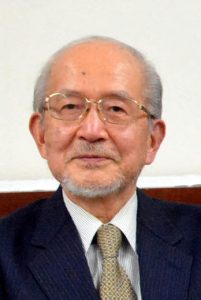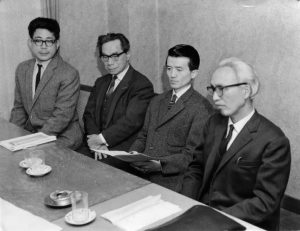People of Hiroshima mourn death of Nobel laureate Kenzaburo Oe — Hisaaki Yamanouchi, Hiroshima native, professor emeritus at Tokyo University, friend of Mr. Oe
Mar. 14, 2023
Translator into English of Nobel Prize acceptance speech, Mr. Yamanouchi calls Mr. Oe “great spokesperson of the times”
by Kyosuke Mizukawa, Senior Staff Writer
Hisaaki Yamanouchi, 88, Hiroshima native and professor emeritus in English literature at the University of Tokyo who lives in the capital city, praised Mr. Oe’s achievements after hearing the news on March 13 of the writer’s death. “He had been interested in Hiroshima since his youth and was a great spokesperson during the period from 1945 to the present.” Mr. Yamanouchi was a friend from their time at university and translated into English Mr. Oe’s acceptance speech, titled “Japan, the Ambiguous, and Myself,” when he was awarded the Nobel Prize for literature in 1994.
Mr. Yamanouchi met Mr. Oe, who was from Ehime Prefecture, at the University of Tokyo, which he had entered after graduating from high school in Hiroshima City. “There was a sense of closeness between us because we were from provinces facing each other across the sea,” Mr. Yamanouchi said. Their friendship deepened after Mr. Oe let him read the poems he had written. Mr. Yamanouchi, an A-bomb survivor who had lost his father in the atomic bombing, made an appearance in Mr. Oe’s work Hiroshima Notes, published in 1965, in which he is described as an old college friend from Hiroshima who never spoke about the tragic event during their four years of college.
Nevertheless, Mr. Oe asked Mr. Yamanouchi to translate into English the manuscript of his acceptance speech, which mentioned the devastation wrought by the atomic bombings of Hiroshima and Nagasaki, when he received the Nobel Prize for literature. “In the speech, he mentioned the suffering of not only Japanese but also those from the Korean Peninsula, in which he showed an interest from a young age. I feel honored that he entrusted me with the translation,” Mr. Yamanouchi said. He also expressed regret for his failure to send a letter to Mr. Oe on his 88th birthday at the end of January earlier this year.
Showing empathy for disadvantaged, Mr. Oe communicated Hiroshima’s hopes in Japan and overseas
A-bomb survivors and other people in Hiroshima with a connection to Kenzaburo Oe lamented his death when the news was reported on March 13. Hiroshi Harada, 83, an A-bomb survivor who lives in Hiroshima’s Asaminami Ward, provided Mr. Oe with a tour of the Hiroshima Peace Memorial Museum, in the city’s centrally located Naka Ward, as museum director and explained his own experience in the atomic bombing in 1995. “He listened to my story earnestly. He showed empathy for A-bomb survivors and communicated the hopes of Hiroshima both in Japan and overseas,” said Mr. Harada, expressing his gratitude.
Terumi Tanaka, 90, co-chair of the Japan Confederation of A- and H-Bomb Sufferers Organizations (Nihon Hidankyo) who lives in Niiza City, Saitama Prefecture, remembers Mr. Oe as someone who came to encourage him and others staging a sit-in in front of Japan’s former Health and Welfare Ministry’s offices as they demanded the expansion of relief measures for those affected by the atomic bombings. “There was a certain authority to the few words he spoke at the time. I always felt his affection for the disadvantaged,” said Mr. Tanaka with a touch of nostalgia.
In Hiroshima Notes, Mr. Oe introduced Ichiro Moritaki, an A-bomb survivor, and his wife, Shige, who continued their criticism of the atomic bombings, writing that in them he found “nobility.” Their second oldest daughter, Haruko, 84, a resident of Hiroshima’s Saeki Ward, said, “He placed himself in Hiroshima, the very site where human dignity was trampled on, and looked at the A-bombed city from a level-headed perspective.”
Norikazu Shigeto, 81, a resident of Higashihiroshima City in Hiroshima Prefecture who is the oldest son of Fumio Shigeto, the first director of the Atomic-bomb Survivors Hospital who also appears in the book, mourned the passing of Mr. Oe. “It is a difficult time with Russia’s invasion of Ukraine and other issues to be addressed. I was hoping to hear more from Mr. Oe about his thoughts on that situation.”
In 2011, Mr. Oe and others formed the No More Hibakusha Project, leading the movement calling for independence from nuclear power generation. He also was long dedicated to support through donations of a care center for A-bomb survivors in Yamaguchi City called Yuda-en. Taku Yashiro, 40, director of Yuda-en, said while looking ahead, “I can still sense Mr. Oe’s strong desire for peace. We have to follow in his footsteps.”
(Originally published on March 14, 2023)









